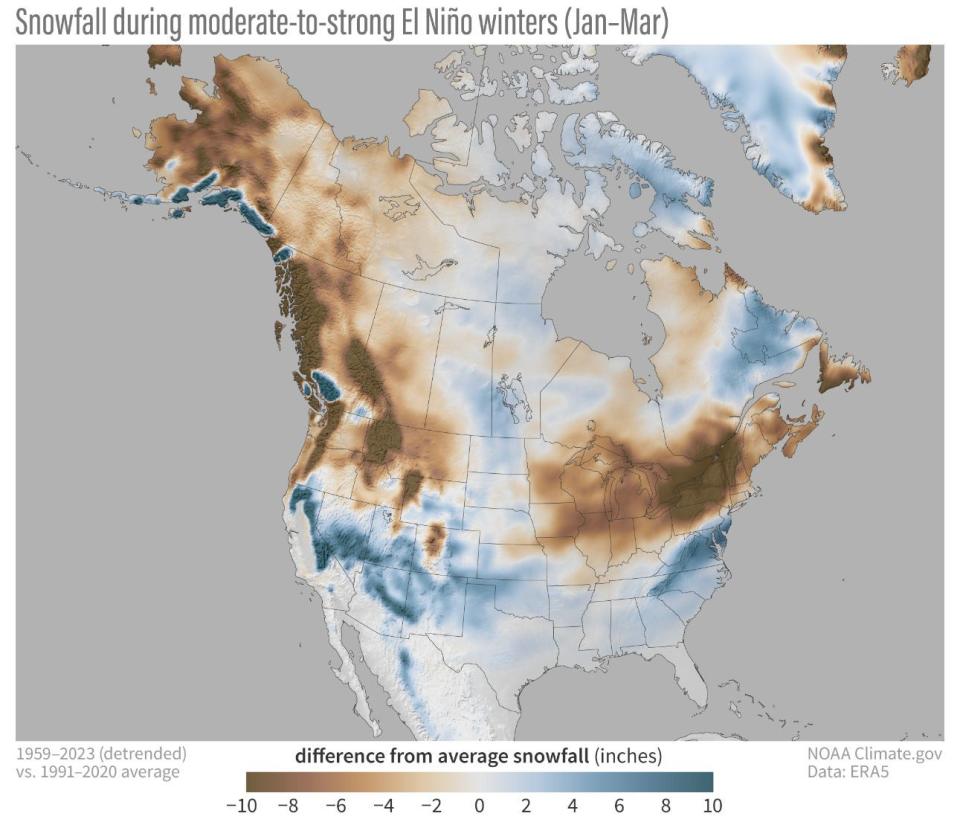It's an El Niño winter. What that means for Rochester.
While we’ve had plentiful coverage on the warmer-than-average Christmas forecast, the bulk of winter — with more snow and cold — is yet to come.
One factor contributing to the warm start to winter in Rochester is El Niño. The last time there was a strong El Niño event was in 2015-16, a year when the region saw 50-degree temperatures on Christmas Day.
What is El Niño?
El Niño occurs when westerly trade winds along the equator, which push warm Pacific Ocean water toward Asia and Australia, weaken and warm water is pushed back toward equatorial South America. This pushes the Pacific jet stream further south and east, leading to warm and wet conditions in the Gulf Coast and Southeast in the United States.
Conditions in the north are more likely to remain warmer and drier during El Niño than the typical year.
El Niño does not happen on a regular cycle, occurring every two to seven years.
La Niña is the opposite of El Niño and occurs when trade winds are particularly strong, bringing cold Pacific Ocean water to the surface by South America and pushing the Pacific jet stream northward. As a result, La Niña typically causes the northern U.S. to be colder and wetter and the southern U.S. is warmer and drier.
El Niño and La Niña typically last about nine months to a year and don’t occur on regular intervals. The full name for El Niño is El Niño de Navidad, because it usually peaks around December. NOAA expects the current El Niño to last through winter before transitioning to a neutral state in April.

How will El Niño affect Rochester NY this winter?
The reality for El Niño can be far less predictable than the general description, however.
The same 2015-16 El Niño event that brought warm temperatures to New York at Christmas flipped the script on the West Coast: Seattle saw its then-wettest winter on record, while much of the Southwest saw below average rain and snow.
The El Niño game plan was followed in the Rochester area, though. The seasonal summary from the National Weather Service in Buffalo said the 2015-16 winter could be summed up with two words: warmer and drier.
The 2015-16 winter saw 16 record-breaking high temperatures between November and the end of March, according to the Weather Service. Those record highs included 68 degrees on Dec. 24 and a string of three days warmer than 70 degrees in early November.
Rochester saw just 63.7 inches of snow that winter and there were 39 days with 1 inch of snow or more on the ground. The normal seasonal snowfall average is around 102 inches.
For now, the Weather Service’s Climate Prediction Center expects above average temperatures and precipitation in the 6-10 day outlooks, with above- or near-average temperatures expected into mid-January. The precipitation outlook remains below average into the new year, but a typical chance of precipitation for Jan. 5 to 19.
What I’m working on
I spoke with Weather Service Warning Coordination Meteorologist Mike Fries about his experience with the ‘22 Buffalo blizzard last week, including a look at how the storm formed and why it became such a strong system.
I’ll spend some time this week looking at historical weather data to answer questions about Rochester’s coldest and snowiest months. What weather questions do you have? Reach out to me at showe@gannett.com.
More: Christmas Day in Rochester could be the warmest in decades. How warm will it get?
More: Winter weather driving tips. What you should know this season
Steve Howe covers weather, climate and lake issues for the Democrat and Chronicle and his New Year’s resolution is to run more in 2024. Have any insight into changing weather or climate? Share with him at showe@gannett.com.
This article originally appeared on Rochester Democrat and Chronicle: Rochester NY El Nino winter weather

